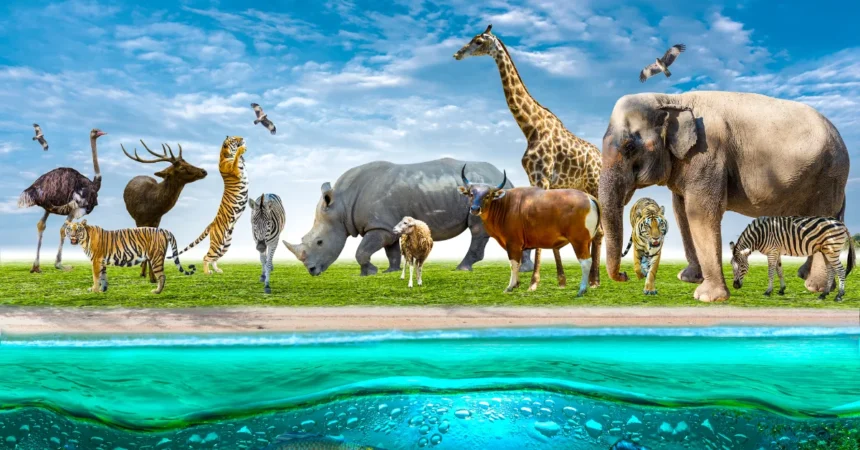The World Wildlife Fund (WWF) has recently released a report that highlights the shocking decline in global wildlife populations over the past few decades. According to their findings, wildlife populations have plummeted by an average of 69% since 1970, primarily due to human activities such as habitat destruction, pollution, and climate change. This article explores the critical issues surrounding wildlife population decline, the implications for ecosystems and humanity, and the urgent need for effective conservation strategies.
The Scale of the Decline
The WWF’s Living Planet Report is a comprehensive study that evaluates the health of the world’s ecosystems and the species that inhabit them. The most recent data reveal that vertebrate populations, which include mammals, birds, fish, reptiles, and amphibians, have experienced a staggering average decline of 69% in just over 50 years. This statistic underscores the severity of the biodiversity crisis that we face today.
Key Findings from the WWF Report
- Aquatic Species Hit Hardest: Freshwater species have experienced the most significant decline, with populations decreasing by 83% since 1970. This alarming trend is largely attributed to habitat loss due to dam construction, pollution, and overfishing.
- Regional Disparities: The report indicates that wildlife populations in tropical regions are suffering more than in temperate areas. The decline in Latin America and the Caribbean is particularly stark, with an average decrease of 94% in vertebrate populations.
- Impact of Human Activities: Habitat destruction due to agriculture, urban development, and deforestation are primary drivers of wildlife population decline. Furthermore, climate change poses an additional threat, altering habitats and affecting migration patterns.
Factors Contributing to Wildlife Population Decline
The decline in wildlife populations can be attributed to several interconnected factors, many of which stem from human activities:
1. Habitat Destruction
Habitat loss is perhaps the most critical factor affecting wildlife populations. As human populations grow, natural habitats are increasingly converted for agricultural, urban, and industrial use. This encroachment leads to fragmentation of ecosystems, making it difficult for species to find food, mates, and shelter.
2. Climate Change
Climate change is reshaping ecosystems around the world. Rising temperatures, shifting rainfall patterns, and extreme weather events are altering habitats, making them unsuitable for many species. For instance, polar bears are struggling to find sufficient sea ice for hunting due to melting ice caps.
3. Pollution
Pollution from plastic waste, chemicals, and pesticides poses a significant threat to wildlife. Marine animals ingest plastic debris, mistaking it for food, leading to injury or death. Similarly, pesticides can disrupt reproductive systems in birds and other wildlife, contributing to population declines.
4. Overexploitation
Overfishing and illegal wildlife trade continue to threaten many species. Unsustainable hunting and fishing practices deplete populations faster than they can replenish, while poaching for exotic pets and traditional medicine drives some species to the brink of extinction.
Consequences of Wildlife Population Decline
The decline of wildlife populations has far-reaching implications for ecosystems and humanity. Healthy ecosystems provide essential services, including clean air, water, and fertile soil. The loss of biodiversity can lead to ecological imbalances, impacting food security and human health.
1. Ecosystem Stability
Wildlife plays a crucial role in maintaining ecosystem stability. For instance, predators help regulate prey populations, preventing overgrazing and promoting plant diversity. When key species decline or disappear, it can lead to a cascade of effects that disrupt the entire ecosystem.
2. Impact on Human Health
Biodiversity is vital for human health, providing resources for medicine, food, and clean water. A decline in wildlife can lead to increased disease transmission, as many infectious diseases originate from wildlife. The COVID-19 pandemic has underscored the connection between wildlife health and human health, highlighting the need for conservation efforts.
3. Economic Consequences
The decline of wildlife populations also has economic ramifications. Many industries, such as tourism and fishing, rely on healthy ecosystems and diverse wildlife. As populations decline, the potential for eco-tourism diminishes, affecting local economies that depend on these resources.
Urgent Need for Conservation
The alarming decline in wildlife populations necessitates immediate action to protect and conserve biodiversity. Governments, organizations, and individuals must work together to implement effective conservation strategies.
1. Protecting Habitats
Establishing protected areas is crucial for safeguarding habitats and the species that inhabit them. National parks, wildlife reserves, and marine protected areas can provide safe havens for wildlife and allow populations to recover.
2. Sustainable Practices
Adopting sustainable agricultural, fishing, and forestry practices can help mitigate the impact of human activities on wildlife. By reducing habitat destruction and pollution, we can create a more balanced relationship between humans and nature.
3. Raising Awareness
Public awareness and education are essential in fostering a conservation-minded society. Campaigns that highlight the importance of biodiversity and the consequences of wildlife decline can mobilize communities to take action.
Success Stories in Conservation
Despite the grim statistics, there are numerous success stories in wildlife conservation that offer hope and demonstrate that positive change is possible.
1. Recovery of Endangered Species
Several species have made remarkable recoveries due to concerted conservation efforts. The American bald eagle, once on the brink of extinction, has rebounded thanks to legal protections and habitat restoration. Similarly, the population of gray wolves in Yellowstone National Park has increased since their reintroduction, illustrating the positive effects of targeted conservation strategies.
2. Community-Based Conservation
Community-based conservation initiatives have proven effective in involving local populations in wildlife protection. Programs that incentivize communities to preserve habitats and protect endangered species have demonstrated success in places like Namibia, where community conservancies have led to increased populations of elephants and rhinos.
Global Collaboration for Biodiversity
Addressing the decline in wildlife populations requires global collaboration and a unified approach. International agreements, such as the Convention on Biological Diversity, emphasize the need for countries to work together to protect biodiversity and promote sustainable practices.
1. Policy and Legislation
Strong policies and legislation are essential for wildlife conservation. Countries must commit to enforcing laws that protect endangered species and their habitats. Additionally, international cooperation is vital to combat illegal wildlife trade and ensure that conservation efforts are effective across borders.
2. Funding for Conservation Efforts
Increased funding for conservation initiatives is crucial for implementing and sustaining effective programs. Governments, NGOs, and private sectors should collaborate to allocate resources toward biodiversity conservation, habitat restoration, and community engagement.
The decline in wildlife populations is a pressing issue that requires immediate attention and concerted efforts from all sectors of society. By recognizing the importance of biodiversity and taking action to protect wildlife, we can work towards a sustainable future for both ecosystems and humanity.
#WildlifePopulationDecline #WWF #Biodiversity #Conservation #Ecosystems #SustainablePractices #HabitatProtection #ClimateChange #EndangeredSpecies #EcoTourism







